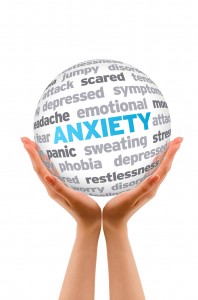Being ‘fear fit’ is all about:
- identifying if the fear we are feeling is one that will help us, or if its a fear that will harm us, and
- expanding our comfort zone so that we become increasingly more comfortable with feeling our fear and reacting accordingly.
Basically, fear can either protect us from getting hurt by preventing us from doing things we probably shouldn’t be doing (the ‘fight or flight’ mechanism), or fear can show us what is really important to us and become an indicator that guides us along our right path.
Unfortunately, most of us tend to identify all of our fears as the ‘fight or flight’ type and miss out on the opportunity of letting fear help us figure out what is really important to us. After all, if what we were doing or thinking about doing wasn’t important to us, we wouldn’t care if we did it or not and we wouldn’t feel fear when we thought about it or tried to move towards it.
How Can You Tell if You are Feeling a Good Fear
A good fear is one that is trying to help you, or a protective fear, one that is trying to prevent you from hurting yourself??
An effective technique is to recognize when you are feeling fearful and to identify what you are thinking about or doing that evoked the fear response.
Take, for example, a situation where you are thinking about making a major lifestyle change. You want to incorporate into your life something you have been dreaming about doing for a long time, like becoming self-employed or becoming a professional Travel Writer.
If every time you begin to think about opening your own business or being a Travel Writer you begin to feel fearful, then you should analyze that fear. Ask your self if the fear is identifying something that is important to you, or is the fear trying to protect you from hurting yourself?
If you believe the fear is trying to protect you from hurting yourself, then make a list of everything you can think of that might hurt you if you made this change. Go through the list and identify any fear that is related to a situation that you can develop a coping strategy for. The coping strategy could be anything that either reduced the impact of the situation, changed the way you felt about the situation, or eliminated the situation all together.
Coping Strategies Can Help Overcome Fear
If you can identify coping strategies for most or all of the fears you identified, then the original fear you felt was very likely to have been a good fear. This is the kind of fear that identifies things that are important to you and lets you know you are on your right path.
I did this exercise recently and was quite surprised by the results. Of course, these weren’t my fears that I was analyzing, which made the exercise a whole lot easier to do.
A few years ago a Location Independent/Digital Nomad Survey was run online to an audience that was either living the location independent lifestyle, or was extremely interested in creating an independent lifestyle. The author’s of the study identified 268 people responding to the study (94 individuals who were living a location independent lifestyle, and 174 aspiring location independents). The location independent lifestyle is a lifestyle design that combines extensive travel with a career or self-employment, something that requires a fairly high fear threshold.
One of the questions asked participants to identify fears that they had regarding either living this lifestyle, or planning to live this lifestyle.
A total of 86 unique fears were shared by the 268 participants. Several of the fears were shared by dozens of the respondents.
In looking at each fear I asked myself if I could develop a coping strategy for that fear, or if this was a ‘protective’ fear that identified a situation that would be totally beyond my control and therefore something I could not develop a coping strategy for and should be afraid of. Over 90% of the identified fears were fears that a coping mechanism could be identified for, with less than 10% being the ‘protective’ kind of fear — fears that identified situations that were outside of the individual’s control. What I found most interesting was that 80% of the ‘protective fears’ were identified by people who were already living a location independent lifestyle (these included fears of plane crashes, border control problems, not getting home in time if a loved one died, those kinds of fears).
Using the idea of being ‘fear fit’, it seems that the aspiring Location Independent/Digital Nomads that participated in the survey were experiencing the ‘good fear’ — the kind of fear that indicates that they have found a lifestyle choice that is important to them.
So the first half of being ‘fear fit’ is to identify and analyze your fears in order for you to determine which fears are acting like a ‘fear radar’ and are showing you what is important to you, and which fears are the ‘fight or flight’ type of fears that are protecting you from harm.
The second half of being ‘fear fit’ is to learn how to find the courage to expand your comfort zone so that you can stop letting your fears prevent you from doing things that are important to you.
One very effective technique for overcoming this type of fear is to find small, safe challenges in your life and do at least one of these challenges every day. Challenges could be as simple as finding a new route to work or home from work; shopping in a store that you have never shopped in before; rearrange the furniture in one room of your home; try eating in a new restaurant; try having breakfast for dinner.
Basically anything that takes you outside of your normal routine, that challenges your habits can expand your comfort zone and help inoculate yourself to small amounts of fear.
As you become comfortable with your newly expanded comfort zone, challenge yourself again. The key is to expand your comfort zone in small, easy steps. Before long you will find that both your fear tolerance level and your comfort zone have expanded nicely.
If you enjoyed reading this then you will love receiving my bi-weekly Clarity and Creativity Newsletter. Every newsletter is loaded with goodies like: Clarity and Creativity posts; tips and techniques on how to gain Clarity and boost your Creativity; Resources; as well as special deals on Coaching, Programs, and other awesome stuff!! Sign up is easy , just click on this link: Clarity and Creativity Newsletter Signup Page or enter your email address in the signup box at the top right-hand corner of this page. Thank you for visiting 🙂

